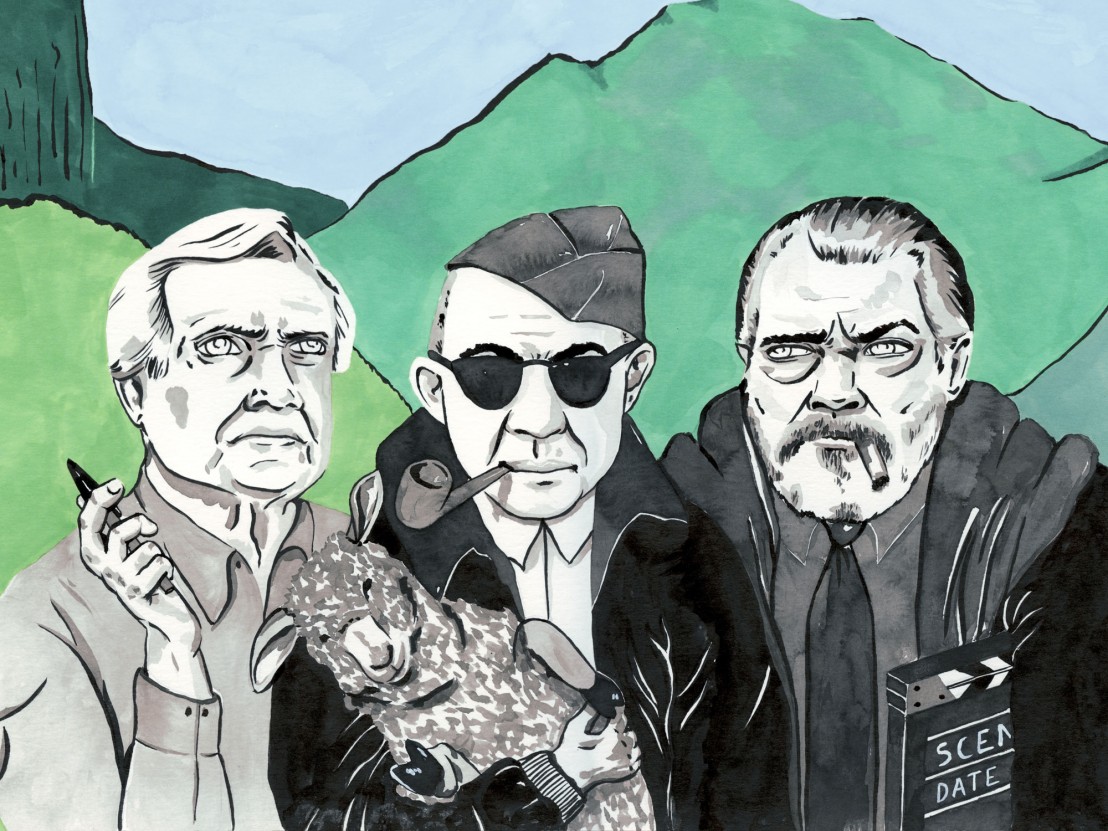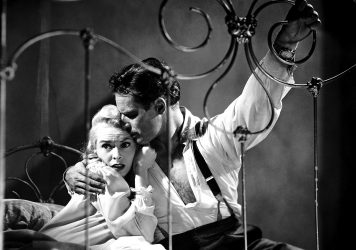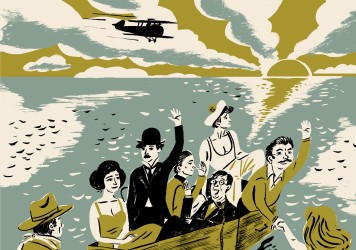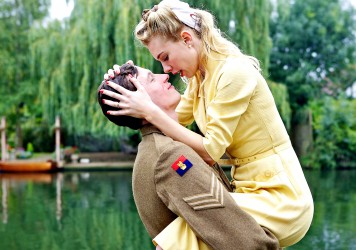
The story of how a trio of legendary filmmakers became entranced by the Emerald Isle.
“When I came here to Wicklow in Ireland, 22 years ago,” begins John Boorman in I Dreamt I Woke Up, his ‘ironic dissertation on life and death’ for the BBC, “I felt I’d come to a place that had always existed in my imagination. That here I could somehow come to myself at last. Is that what home is? Finding in the outer world a place that coincides with an inner landscape?”
Boorman came to Ireland in 1969 to complete post-production on his fourth feature, Leo the Last, impetuously plunging his savings into a late-Georgian Church of Ireland rectory at Annamoe that he’s called home ever since. “It felt like the setting for the Arthurian legend,” he wrote in his 2003 memoir ‘Adventures of a Suburban Boy’, speaking of a landscape that inspired an aborted stab at The Lord of the Rings, a singular sci-fi oddity in 1974’s Zardoz and the culmination of his lifelong obsession with the grail mythology in 1981’s Excalibur.
Both the memoir and I Dreamt I Woke Up are steeped in Boorman’s affection for the spiritual, the paganistic and the pre-historical; a deep acknowledgement of his adopted land’s kindling of the creative process. “The soft, feminine folds of the hills, the bleak bogs, the ancient oak woods, the black lakes, the urgent streams… It was harmonious. It fitted… I belonged at last.”
Of course, Boorman wasn’t the first filmmaker to be entranced by the Emerald Isle. In the summer of 1931, a plump 16-year-old boy atop a donkey named Sheeog could be found roaming the Connemara wilds. By October, he’d found his way to Dublin, talked his way into the company of the Gate Theatre and introduced the theatrical establishment to a certain Orson Welles.
“I was from America,” Welles told the director and film historian Peter Bogdanovich in 1969, “and in Ireland, back in those distant days, anything American was possible, however unlikely. I informed the directors of the Gate Theatre that I was that same Welles they must have read about. Just for the lark of it, I told them I’d enjoy the experience of playing with their company for a play or two – that is, if any leading roles were available… [They] started me off with as juicy a principal part as any grizzled veteran could ask for, in ‘Jew Süss’. So that’s how I began – right at the top. I’ve been working my way down ever since.”
The play was rapturously received, and Welles stayed on at the Gate for a brief time, playing smaller roles before returning to New York the following year. It wasn’t until January 1952 – more than a decade after Citizen Kane – that Welles finally got to make a film in Ireland. A break in the editing of Othello afforded him the opportunity to reunite with his Gate Theatre mentors, Hilton Edwards and Michael MacLiammoir (also his Iago) to star in the Oscar-nominated short, Return to Glennascaul.

Welles’ arrival in Dublin was hardly a celebratory homecoming. His visit to the Gate’s production of Tolka Row was marred by a mob of screaming protestors organised by the Catholic Cinema and Theatre Patron’s Association, placards held aloft labelling him a communist. His waves to the demonstrators from the theatre windows did little to quell the mood, and after a quick speech onstage he legged it down the fire escape.
The film itself proved much more successful. Running at a mere 23 minutes, it’s a witty ghost story that, despite being directed by Hilton Edwards, feels every bit a part of Welles’ work. The boy wonder’s sense of mischief – of meta-narrative invention – is present from the opening scene, as Welles breaks from filming Othello to introduce the tale. Naturally, he proceeds to narrate and insert himself into bookending scenes, cementing a through-line from his early radio plays to the quizzical narrative concerns of F for Fake. That the film even looks like one of his, however, can’t be laid at Welles’ feet; it was shot by George Fleishmann, a camera-operator who – according to Simon Callow’s recent Welles biography – crash-landed on a reconnaissance mission in 1942 and decided to stay. Cameramen are as susceptible as directors, it seems, to the country’s charms.
“I love Ireland,” remarked Welles in 1984, “I love Irish literature, I love everything they do. But the Irish-Americans have invented an imitation Ireland which is unspeakable. The wearin’ o’ the green. Oh my God! To vomit!” One has to assume that Welles’ contempt for the Americanisation of the stateside Irish diaspora didn’t extend to that most famous of Irish-Americans, especially given the 1967 interview with Playboy magazine in which he declared that the filmmakers who appealed to him most were the “old Masters – by which I mean John Ford, John Ford and John Ford.”
In his 2001 biography ‘Searching for John Ford’ Joseph McBride notes that, “The Irish producer Charles Fitzsimons felt that Ford ‘had one great emotional tragedy in his life… that he hadn’t been born in Ireland.’” A deeply-rooted romanticism towards his parents’ homeland suffuses the cinema of John Ford, echoing far beyond those shot or set in Ireland itself. His family lineage in the country can be traced back to the year 350 (Ford himself was born to first-generation émigré parents in Portland, Maine in 1894).
If his prodigious knack for personal myth-making complicates the task of parsing details from his own Irish adventures (not least when it comes to a 1921 trip in support of the revolutionary cause), one need only look at the films – from 1926’s The Shamrock Handicap to 1965’s Young Cassidy – for vivid reflections of the childhood visits with his father described by McBride: “John came away with a deep emotional attachment to Ireland… fully aware of the pictorial splendour of the landscape and its connections with the lives of ordinary people. As Orson Welles once said of him, ‘John Ford knows what the earth was made of.’”
Ford’s Irish films tackle questions of modernity and tradition, of city and rural living, paying homage to a literary and theatrical heritage both in concept and production to varying degrees of success. The director was turned down by Sean O’Casey for his 1935 film The Informer, having asked the great Irish playwright to tackle the screenplay. The relationship hardly improved with Ford’s screen adaptation of O’Casey’s controversial play ‘The Plough and the Stars’ the following year, as mounting studio interference in everything from casting to the final cut alienated both author and filmmaker.
The play caused riots at its Dublin premiere in 1926, nationalists furious at its representation of the 1916 rebellion – events dramatised in Ford’s 1965 account of O’Casey’s life, Young Cassidy. Problems followed the director into that production too, illness allowing him to complete a mere 13 days of the shoot before he was replaced by Jack Cardiff.
More successful artistically – if doubly problematic politically – was Ford’s 1957 portmanteau film, The Rising of the Moon. Of the three short literary adaptations that make up the film, it was the third (titled ‘1921’) that saw it pulled from distribution, its updating of Lady Gregory’s 1907 play to the Black and Tan wars viewed as a potential inciter of violence. The film was made under the banner of Four Provinces Films, a new production company on whose board Ford served, the intention being to bring about a fully indigenous film industry. “In the last few decades our writers and actors have been leaving our shores,” said Ford, “Why should they have to go? Why can’t we keep them at home? If this film is a success it will usher in an era in which our exiled artists will be glad to come home and work for an Irish film industry.” The film flopped, along with the director’s industrious dream.

Fifty years on, it’s Ford’s 1954 film The Quiet Man that stands as the director’s most vivid portrait of a timeless Ireland bathed in a rich nostalgic hue. Its story of an Irish-American’s return to the land of his father forgoes naturalism for a heightened sense of fantastic romanticism, depicting an Ireland that bears little relation to its real-world counterpart but one forged out of tradition and memory. Some iffy sexual politics aside, the film is masterfully shot and directed; the passion for the land and culture expressed by John Wayne’s Sean Thornton. Ford re-staged a horse race seen in his 1928 silent film, Hangman’s House, and ended it with one of cinema’s most enduring bouts of fisticuffs. He may (at best) be trading in archetype or (at worst) stereotype, but Ford’s enduring affection for “the only place I have found peace” ensures that it transcends its rose-tinted glow.
Other major filmmakers were similarly powerless to resist an Irish sojourn. Douglas Sirk filmed his Rock Hudson-starring tale of highway piracy, Captain Lightfoot, there in 1955; a formalist’s dream of colour and costume typically more interested in buckles than swash. The making of David Lean’s 70mm epic, Ryan’s Daughter in Dingle, is lovingly recounted in the documentary, A Bit of a Fillum – a bittersweet experience for Lean given the critical mauling it received, which kept him away from the camera for 14 years.
It should come as no surprise that John Huston begins his reflections on Ireland in his 1990 autobiography with an appreciation of the charms of Irish women, before settling into numerous pages on the thrill of fox hunting. Huston bought his estate at St Clerans in the early ’60s, finally becoming an Irish citizen in 1964, an honorary doctorate from Trinity University bestowed on him: “Although my artistic contributions to the world were extolled, this occasion was also tinged with a bit of Irish provincialism: ‘Recently [Huston] has become an Irish citizen and lives in Galway, where, they say, the local foxes have learned to fear his prowess as a hunter… Lots of people can write, direct and act in films, but few can sit well an Irish hunter.”
Huston retooled the ending of his 1963 film The List of Adrian Messenger in order to shoot an extended fox hunt on his estate, a terrific set-piece in a strange film that recalls the horse-wrangling sequence of The Misfits. He continued to film in and around St Cleans through the late ’60s and early ’70s, although little of note beyond a pair of nifty chase sequences with Paul Newman in 1973’s The Mackintosh Man.
More interestingly, the production of his marvellous 1956 adaptation of ‘Moby Dick’ completely took over the town of Youghal, near Cork, which served as a stand-in for the harbour of New Bedford. All the businesses in town agreed for their fronts to be set-dressed to resemble New England, with the exception of one publican who held out for more money. The whole town turned on him, boycotting his bar, before Huston intervened: “I dropped by with a couple of friends. It was empty. The owner recognised me, and I said, ‘I’m sorry to hear what’s happened to you.’ He shrugged. ‘I had it coming. I was trying to get something for nothing.’ Where but in Ireland would you ever hear such an admission?”
Huston’s final love letter to his adopted home also prove to be his swan song. In 1987 he released what amounts to the finest cinematic adaptation of James Joyce, The Dead, written by Houston’s son Tony and starring daughter Anjelica. Joyce remains a writer of resilient resistance to the screen, with little in Huston’s visual style that would suggest the lucid moments of poignancy and grace that appear here. It’s a film dipped in a whiskied glow, a keenly felt miniature of celebration and subtle power – a devastating monologue, a stairway song – with a suitably Hustonian sense of doomed masculinity. The film ends with a passage from Joyce, a monologue on death and transience played out across snow-swept tableaux of that enchanted landscape:
“Snow is general all over Ireland, falling on every part of the dark central plain. From the treeless hills, softly upon the bog of Allen, and farther westward, softly falling into the dark mutinous Shannon waves. One by one we’re all becoming shades. Better to pass boldly into that other world in the full glory of some passion than fade and wither dismally with age…”
Published 17 Mar 2016

Orson Welles is some kind of a man in this grisly, ultra-melancholic border-town noir from 1958.

An alphabetic index of the most marvellous and memorable final movies from famous directors.

British veteran John Boorman returns with a jolly follow-up to his beloved Hope and Glory.